03 - Question bank PDF

| Title | 03 - Question bank |
|---|---|
| Course | Business Databases: Design & Processing |
| Institution | California State University Fullerton |
| Pages | 15 |
| File Size | 131.2 KB |
| File Type | |
| Total Downloads | 34 |
| Total Views | 125 |
Summary
Question bank...
Description
Database Processing, 13e (Kroenke/Auer) Chapter 3: The Relational Model and Normalization 1) All relations are tables, but not all tables are relations. Answer: TRUE Diff: 1 Page Ref: 120 2) A relation is a three-dimensional table. Answer: FALSE Diff: 2 Page Ref: 121 Fig 3-4 3) A characteristic of a relation is that the cells of the relation hold a single value. Answer: TRUE Diff: 1 Page Ref: 121-123 Fig 3-4 4) A characteristic of a relation is that the rows of a relation may hold identical values. Answer: FALSE Diff: 2 Page Ref: 121-123 Fig 3-4 5) A relation is a table composed of columns and rows. Answer: TRUE Diff: 1 Page Ref: 121-123 Fig 3-4 6) In relational terms as defined by E.F. Codd, a row is called a tuple. Answer: TRUE Diff: 1 Page Ref: 123-124 Fig 3-9 7) In relational terms as defined by E.F. Codd, a column is called an attribute. Answer: TRUE Diff: 1 Page Ref: 123-124 Fig 3-9 8) The columns of a relation are sometimes called tuples. Answer: FALSE Diff: 1 Page Ref: 123-124 Fig 3-9 9) A tuple is a group of one or more columns that uniquely identifies a row. Answer: FALSE Diff: 1 Page Ref: 123-124 Fig 3-9 10) A functional dependency is a relationship between attributes such that if we know the value of one attribute, we can determine the value of the other attribute. Answer: TRUE Diff: 1 Page Ref: 124
1 ScholarStock
11) If by knowing the value of A we can find the value of B, then we would say that B is functionally dependent on A. Answer: TRUE Diff: 2 Page Ref: 124 12) In functional dependencies, the attribute whose value is known or given is referred to as the determinant. Answer: TRUE Diff: 2 Page Ref: 124 13) Attribute Y is functionally dependent on attribute X if the value of attribute X determines the value of Y. Answer: TRUE Diff: 2 Page Ref: 124-126 14) The functional dependency noted as A → B means that the value of A can be determined from the value of B. Answer: FALSE Diff: 1 Page Ref: 124-126 15) In the functional dependency shown as A → B, B is the determinant. Answer: FALSE Diff: 2 Page Ref: 124-126 16) Functional dependencies can involve groups of attributes. Answer: TRUE Diff: 1 Page Ref: 124-126 17) Given the functional dependency (A, B) → C, the attributes (A, B) are referred to as a composite determinant. Answer: TRUE Diff: 2 Page Ref: 124-126 18) Given the functional dependency A → (B, C), then it is true that A → B and A → C. Answer: TRUE Diff: 3 Page Ref: 124-126 19) Given the functional dependency (A, B) → C, then it is true that A → C and B → C. Answer: FALSE Diff: 3 Page Ref: 124-126 20) Given the functional dependency A → B, then it is necessarily true that B → A. Answer: FALSE Diff: 3 Page Ref: 124-126
2 ScholarStock
21) A determinant of a functional dependency may or may not be unique in a relation. Answer: TRUE Diff: 2 Page Ref: 128-129 22) A key is a combination of one or more columns that is used to identify particular rows in a relation. Answer: TRUE Diff: 1 Page Ref: 129 23) A row can be uniquely identified by a key. Answer: TRUE Diff: 1 Page Ref: 129 24) A combination key is a group of attributes that uniquely identifies a row. Answer: FALSE Diff: 1 Page Ref: 129 25) A key can be composed of a group of attributes taken together. Answer: TRUE Diff: 1 Page Ref: 129 26) It is possible to have a relation that does not have a key. Answer: FALSE Diff: 3 Page Ref: 129-130 27) A candidate key is one of a group of keys that may serve as the primary key in a relation. Answer: TRUE Diff: 1 Page Ref: 129-130 28) A relation can have only one candidate key. Answer: FALSE Diff: 2 Page Ref: 129-130 29) A primary key is a candidate key that has been selected to uniquely identify rows in a relation. Answer: TRUE Diff: 1 Page Ref: 129-130 30) A surrogate key is an artificial column that is added to a relation to be its primary key. Answer: TRUE Diff: 1 Page Ref: 129-130 31) Surrogate keys usually slow performance. Answer: FALSE Diff: 2 Page Ref: 130
3 ScholarStock
32) Surrogate keys are normally not shown on forms or reports. Answer: TRUE Diff: 1 Page Ref: 130 33) A foreign key is one or more columns in one relation that also is the primary key in another table. Answer: TRUE Diff: 1 Page Ref: 130-131 34) A referential integrity constraint is used to make sure the values of a foreign key match a valid value of a primary key. Answer: TRUE Diff: 1 Page Ref: 130-131 35) A constraint that requires an instance of an entity to exist in one relation before it can be referenced in another relation is called an insertion anomaly. Answer: FALSE Diff: 3 Page Ref: 130-131 36) A referential integrity constraint limits the values of a foreign key. Answer: TRUE Diff: 2 Page Ref: 130-131 37) If a table meets the minimum definition of a relation, it has an effective or appropriate structure. Answer: FALSE Diff: 2 Page Ref: 131-132 38) Undesirable consequences of changing the data in a relation are called "modification anomalies." Answer: TRUE Diff: 2 Page Ref: 131-132 39) A deletion anomaly exists when deleting data about one entity results in the loss of data about another entity. Answer: TRUE Diff: 1 Page Ref: 131-132 40) Relations are classified into "normal forms" based on the types of modification anomalies that they are vulnerable to. Answer: TRUE Diff: 3 Page Ref: 132-134 Fig 3-12 41) Any table that meets the definition of a relation is said to be in first normal form (1NF). Answer: TRUE Diff: 1 Page Ref: 132-134 4 ScholarStock
42) Any table that meets the definition of a relation is in 2NF. Answer: FALSE Diff: 1 Page Ref: 134 43) A relation is in 2NF if and only if it is in 1NF and all non-key attributes are determined by the entire primary key. Answer: TRUE Diff: 2 Page Ref: 134-137 Fig 3-12 44) A relation is in 3NF if and only if it is in 2NF and there are no non-key attributes determined by another non-key attribute. Answer: TRUE Diff: 2 Page Ref: 134-137 Fig 3-12 45) The condition that a non-key attribute determines another non-key attribute is known as transitive dependency. Answer: TRUE Diff: 3 Page Ref: 134-137 Fig 3-12 46) An attribute is considered to be a non-key attribute when it is a non-prime attribute, which means that the attribute is not contained in any candidate key. Answer: TRUE Diff: 3 Page Ref: 134-137 Fig 3-12 47) Candidate keys are called interlocking candidate keys when they share one or more attributes. Answer: FALSE Diff: 3 Page Ref: 134-137 Fig 3-12 48) A relation is in Boyce-Codd Normal Form (BCNF) if and only if it is in 3NF and every determinant is a candidate key. Answer: TRUE Diff: 2 Page Ref: 136-137 49) A defining requirement for Boyce-Codd Normal Form (BCNF) is that every candidate key must be a determinant. Answer: FALSE Diff: 2 Page Ref: 136-138 Fig 3-19 50) Every time we break up a relation during the normalization process, we may have to create a referential integrity constraint. Answer: TRUE Diff: 2 Page Ref: 136-138 Fig 3-19
5 ScholarStock
51) The essence of normalization is taking a relation that is not in BCNF and breaking it into multiple relations such that each one is in BCNF. Answer: TRUE Diff: 2 Page Ref: 136-138 Fig 3-19 52) When designing or normalizing relations, each relation should have only one theme. Answer: TRUE Diff: 1 Page Ref: 142 53) A multivalued dependency exists when a determinant is matched to a set of values. Answer: TRUE Diff: 3 Page Ref: 147-149 54) The multivalued dependency noted as A → → B, means that the value of A determines a set of values of B. Answer: TRUE Diff: 1 Page Ref: 147-149 55) A relation is in 4NF when multivalued dependencies are isolated in their own relation. Answer: TRUE Diff: 2 Page Ref: 150-151 56) A relation is in 4NF if it is in BCNF and it has no multivalued dependencies. Answer: TRUE Diff: 2 Page Ref: 147-151 57) Domain/key normal form requires that every constraint be a logical consequence of the definition of domains and keys. Answer: TRUE Diff: 2 Page Ref: 151 58) A relation that is in domain/key normal form is assured to be free from all anomalies. Answer: TRUE Diff: 2 Page Ref: 151 59) A relation ________. A) has rows containing data about an entity B) has columns containing data about attributes of the entity C) has cells that hold only a single value D) has no two identical rows E) All of the above. Answer: E Diff: 1 Page Ref: 121-123 Fig 3-4
6 ScholarStock
60) In a relation ________. A) entities in a column vary as to kind B) the order of the columns is important C) the order of the rows is unimportant D) more than one column can use the same name E) All of the above. Answer: C Diff: 1 Page Ref: 121-123 Fig 3-4 61) A relation is also known as a(n) ________. A) table B) tuple C) relationship D) attribute E) field Answer: A Diff: 1 Page Ref: 123-124 Fig 3-9 62) A tuple is also known as a(n) ________. A) table B) relation C) row D) field E) file Answer: C Diff: 2 Page Ref: 123-124 Fig 3-9 63) An attribute is also known as a(n) ________. A) table B) relation C) row D) field E) file Answer: D Diff: 2 Page Ref: 123-124 Fig 3-9 64) Saying that two entities are functionally dependent means that ________. A) the entities are always connected by a mathematical equation B) for one of the entities, if we are given the value of that entity, we can determine the value of one other entity C) for both of the entities, if we are given the value of one entity, we can determine the value of the other entity D) the functional dependency will have to be removed through normalization E) All of the above. Answer: B Diff: 2 Page Ref: 124-126 7 ScholarStock
65) Given the functional dependency A → (B, C), A is a(n) ________. A) independent variable B) dependent variable C) determinant D) composite determinant E) C and D Answer: C Diff: 2 Page Ref: 124-126 66) Given the functional dependency (A, B) → C, (A, B) is a(n) ________. A) independent variable B) dependent variable C) determinant D) composite determinant E) C and D Answer: E Diff: 3 Page Ref: 124-126 67) Given the functional dependency (A, B) → C, then ________. A) A → B B) A → C C) B → A D) B → C E) None of the above is correct. Answer: E Diff: 2 Page Ref: 124-126 68) Which of the following is true about the functional dependency A → (X, Y)? A) X is functionally dependent on A. B) A determines Y. C) A is a determinant. D) X and Y are functionally dependent on A. E) All of the above. Answer: E Diff: 3 Page Ref: 124-126 69) Which of the following is true about the functional dependency (A, B) → (C, D)? A) A is the determinant of C. B) A and B together are determined by C and D together. C) A and B together determine D. D) C and D together determine A. E) A determines B. Answer: C Diff: 3 Page Ref: 124-126
8 ScholarStock
70) The only reason(s) for having relations is to ________. A) store instances of functional dependencies B) store equation components C) store equation results D) B and C E) A, B, and C Answer: A Diff: 3 Page Ref: 124-126 71) A combination of one or more columns used to identify particular rows in a relation is a ________. A) record B) field C) key D) tuple E) dependency Answer: C Diff: 1 Page Ref: 128-129 72) A combination of two or more columns used to identify particular rows in a relation is a ________. A) record B) field C) composite key D) foreign key E) surrogate key Answer: C Diff: 1 Page Ref: 128-129 73) A determinant that determines all the other columns in a relation is a ________. A) record B) field C) foreign key D) candidate key E) surrogate key Answer: D Diff: 1 Page Ref: 12129 74) When designing a database, one of the candidate keys in a relation is selected as the ________. A) composite key B) primary key C) foreign key D) surrogate key E) dependency Answer: B Diff: 1 Page Ref: 128-129 9 ScholarStock
75) An artificial column added to a relation to serve as the primary key is a ________. A) composite key B) candidate key C) foreign key D) surrogate key E) dependency Answer: D Diff: 1 Page Ref: 128-129 76) A key consisting of one or more columns that is a primary key in another relation is a ________. A) composite key B) candidate key C) foreign key D) surrogate key E) dependency Answer: C Diff: 1 Page Ref: 129-131 77) Referential integrity constraints are used to limit the possible values of a ________. A) composite key B) candidate key C) foreign key D) surrogate key E) dependency Answer: C Diff: 1 Page Ref: 129-131 78) A ________ is used to limit the possible values of a(n) foreign key. A) composite key B) surrogate key C) functional dependency D) referential integrity constraint E) normal form Answer: D Diff: 2 Page Ref: 129-131 79) Normalization is a process used to deal with which of the following modification anomalies? A) Insertion anomaly B) Update anomaly C) Deletion anomaly D) A and B E) A, B, and C Answer: E Diff: 1 Page Ref: 131-134 10 ScholarStock
80) If the removal of facts about one entity results in the unintentional loss of data about another entity, this is referred to as a(n) ________. A) normalization anomaly B) insertion anomaly C) update anomaly D) deletion anomaly E) removal anomaly Answer: D Diff: 2 Page Ref: 131-134 81) Suppose that you need to update one value of the column SalesCost in a relation. The way the relation is constructed, this value actually needs to be changed in three different rows. However, you only change the value in two of the rows. You have just created an a(n) ________. A) normalization anomaly B) insertion anomaly C) update anomaly D) deletion anomaly E) removal anomaly Answer: C Diff: 2 Page Ref: 131-134 82) A table that meets the definition of a relation is in ________. A) First Normal Form B) Second Normal Form C) Third Normal Form D) Boyce-Codd Normal Form E) Fourth Normal Form Answer: A Diff: 1 Page Ref: 131-134 83) A relation is in second normal form (2NF) if and only if it is in 1NF and ________. A) all non-key attributes are determined by the entire primary key B) there are no non-key attributes determined by another non-key attribute C) every attribute is a candidate key D) every candidate key is a determinant E) every determinant is a candidate key Answer: A Diff: 2 Page Ref: 131-134 Fig 3-12 84) A relation is in third normal form (3NF) if and only if it is in 2NF and ________. A) all non-key attributes are determined by the entire primary key B) there are no non-key attributes determined by another non-key attribute C) every attribute is a candidate key D) every candidate key is a determinant E) every determinant is a candidate key Answer: B Diff: 2 Page Ref: 131-134 Fig 3-12 11 ScholarStock
85) A relation is in Boyce-Codd normal form (BCNF) if and only if it is in 3NF and ________. A) all non-key attributes are determined by the entire primary key B) there are no non-key attributes determined by another non-key attribute C) every attribute is a candidate key D) every candidate key is a determinant E) every determinant is a candidate key Answer: E Diff: 2 Page Ref: 131-134 Fig 3-19 86) If a table is designed so that every determinant is a candidate key, then that relation is in ________. A) First Normal Form B) Second Normal Form C) Third Normal Form D) Boyce-Codd Normal Form E) Fourth Normal Form Answer: D Diff: 2 Page Ref: 131-134 Fig 3-19 87) If a relation is in BCNF, and each multivalued dependency has been moved to a relation of its own, then the first relation is in ________. A) First Normal Form B) Second Normal Form C) Third Normal Form D) Boyce-Codd Normal Form E) Fourth Normal Form Answer: E Diff: 2 Page Ref: 147-151 88) A relation is in fourth normal form if it is in BCNF and it has no ________. A) transitive dependencies B) multivalued dependencies C) partial dependencies D) deletion dependencies E) referential integrity conflicts Answer: B Diff: 2 Page Ref: 147-151
12 ScholarStock
89) A relation is in domain/key normal form if ________. A) every key of the relation is a logical consequence of the definition of constraints and determinants B) every key of the relation is a logical consequence of the definition of constraints and domains C) every constraint on the relation is a logical consequence of the definition of keys and determinants D) every constraint on the relation is a logical consequence of the definition of keys and domains E) every domain of the relation is a logical consequence of the definition of keys and constraints Answer: D Diff: 2 Page Ref: 151 90) In general, each relation should have ________. A) one and only one theme B) one or more themes C) exactly two themes D) one or two themes E) exactly three themes Answer: A Diff: 1 Page Ref: 142 91) What is a functional dependency? Give an example not used in the text. Answer: We say that a functional dependency exists when the value of one or more attributes determines the value of another attributes. For example, suppose we have a six-sided die numbered and colored as follows: Number 1 2 3 4 5 6
Color Red Blue White Green Green Green
In this case, Number functionally determines Color, written as Number → Color. Then, if we know the Number is 3, we know the Color is White. Note that the reverse is not true—Color does not determine Number since if we are given the Color Green the number could be 4, 5, or 6. The attribute on the left-hand side of the dependency is called the "determinant." Thus, Number is a determinant. Although equations can be expressed as functional dependencies [as when the equation TotalCost = NumberSold * ItemCost is written as the functional dependency (NumberSold, ItemCost) → TotalCost] functional dependencies are not equations. Also note that a determinant can have more than one attribute [as does (NumberSold, ItemCost) in the last example] and when it does it is called a composite determinant. Diff: 2 Page Ref: 124-126
13 ScholarStock
92) Describe the requirements that a table must meet to qualify as a relation. Answer: In order for a table to meet the requirements of a relation, it must satisfy certain conditions. First, the rows contain data about an entity or some portion of the entity. Second, the columns contain data that represent attributes of the entity. Third, each column must contain the same kind of data for all rows. Fifth, each column must have a unique name. Sixth, the cells must contain single values—no group or array values are allowed. Seventh, the order of the columns and the rows is insignificant. Finally, the rows must be unique. Diff: 1 Page Ref: 121-123 Fig 3-4 93) Explain the terms relation, tuple, and attribute. Answer: The terms relation, tuple, and attribute are used primarily by database theoreticians. These terms are synonymous with the terms table, row, and column, respectively, in regards to a relational database. They are also equivalent to the terms file, record, and field, which tend to be used by many traditional data processing professionals. Diff: 1 Page Ref: 123-124 Fig 3-9 94) Distinguish between the primary key and a candidate key. Answer: Both the primary key and a candidate key can uniquely identify the rows in a table. The primary key is the candidate key that is chosen by the database designer, working with the users, to uniquely identify rows and to represent relationships. Although any candidate key could, by definition, be selected to act as the primary key, the choice of primary key is often based on design decisions such as the amount of foreign key data that would be generated. Diff: 2 Page Ref: 129-130 95) Briefly describe the various tasks of the primary key. Answer: The primary key is used for four primary tasks. First, it is used to uniquely identify the rows in a table. Second, it is used to represent rows in relationships. Third, most DBMS products use the values of the primary key to organize the storage of the relation. Finally, primary keys are used in indexes and other structures to improve performance for search operations. Diff: 2 Page Ref: 129-130 96) Explain the relationships among primary keys and functional dependencies. Answer: Relations store instances of functional dependencies in their rows. All primary keys represent a functional dependency, since each primary key functionally determines the entire row. Since the primary key determines the entire row, if a primary key wer...
Similar Free PDFs

03 - Question bank
- 15 Pages

Dmdw-question bank - question bank
- 17 Pages

Question bank
- 8 Pages
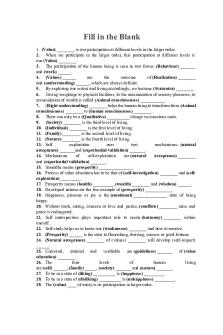
Question Bank 3question bank
- 6 Pages

Question BANK
- 19 Pages

Ch 03 - Test bank
- 23 Pages

hrm test bank 03
- 45 Pages

Chapter 03 - Test bank
- 80 Pages
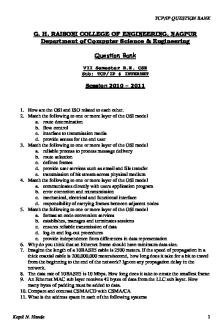
Tcp-ip-question-bank
- 25 Pages

Chapter 4 - Question Bank
- 28 Pages

DIP Question Bank Sheetal
- 14 Pages
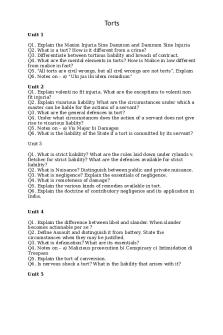
Torts Question Bank
- 2 Pages
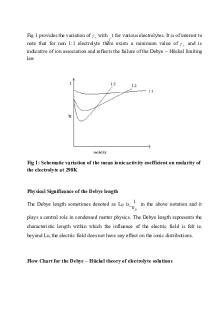
QB5 - Question Bank 5
- 104 Pages

Assessment Question Bank 1
- 22 Pages
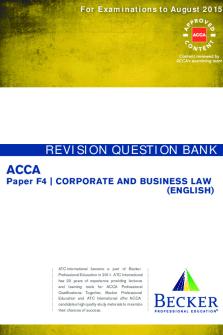
Revision Question Bank 60
- 154 Pages
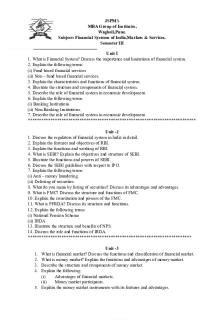
Fsims Question Bank
- 4 Pages
Popular Institutions
- Tinajero National High School - Annex
- Politeknik Caltex Riau
- Yokohama City University
- SGT University
- University of Al-Qadisiyah
- Divine Word College of Vigan
- Techniek College Rotterdam
- Universidade de Santiago
- Universiti Teknologi MARA Cawangan Johor Kampus Pasir Gudang
- Poltekkes Kemenkes Yogyakarta
- Baguio City National High School
- Colegio san marcos
- preparatoria uno
- Centro de Bachillerato Tecnológico Industrial y de Servicios No. 107
- Dalian Maritime University
- Quang Trung Secondary School
- Colegio Tecnológico en Informática
- Corporación Regional de Educación Superior
- Grupo CEDVA
- Dar Al Uloom University
- Centro de Estudios Preuniversitarios de la Universidad Nacional de Ingeniería
- 上智大学
- Aakash International School, Nuna Majara
- San Felipe Neri Catholic School
- Kang Chiao International School - New Taipei City
- Misamis Occidental National High School
- Institución Educativa Escuela Normal Juan Ladrilleros
- Kolehiyo ng Pantukan
- Batanes State College
- Instituto Continental
- Sekolah Menengah Kejuruan Kesehatan Kaltara (Tarakan)
- Colegio de La Inmaculada Concepcion - Cebu